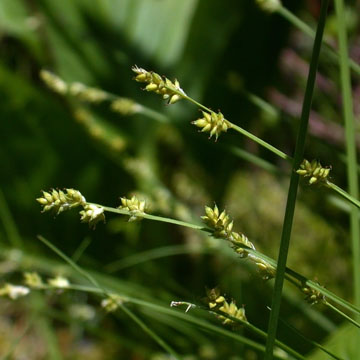

Carex brunnescens - (image 1 of 6)
Taxonomy
Family: Cyperaceae
Section Glareosae
Habitat
Wet-mesic woods, bogs.
Associates
Distribution
Circumboreal, south to NJ, OH, MI, MN, and in mountains to NC.
Morphology
Tufted perennial to 60 cm. Leaves green, to 2.5 mm wide, more or less flat; bracts inconspicuous or the lowest setaceous-tipped and surpassing the spikes. Spikes 4-9, 4-8 mm, brownish or sometimes pale grayish or stramineous; perigynia mostly 5-10, ventrally nerveless or obscurely nerved, finely several-nerved dorsally, somewhat loosely spreading, the beak-apiculations (tips) interrupting the outline of the spike; sack thin distally and easily ruptured. Stigmas 2; achene lenticular.
Notes
Fruiting June to July
Wetland indicator: FACW
The specific epithet means "brownish", probably in reference to the color of the perigynia. A similar species, C. canescens (Grey Bog Sedge), has about 3 times more perigynia per spike with evident ventral nerves; canescens means "whitish" referring to the overall silvery appearance.
References
Gleason, Henry A. and A. Cronquist. 1991. Manual of Vascular Plants of
Northeastern United States and Adjacent Canada. Second Ed.
The New York Botanical Garden. Bronx, NY
Swink, F. and G. Wilhelm. 1994. Plants of the Chicago Region.
Indiana Academy of Science. The Morton Arboretum. Lisle, Illinois.
|
© Michael Hough 2010 |